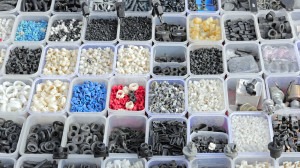When you’re talking about universal best practices for designing parts for injection molding, there are a few that are simply unavoidable. At the top of the list, you’ll almost always find the requirement for draft angles for your parts. (If it isn’t draft angles, it’s probably uniform wall thickness, detailed here previously.)

We’ll cover a bit more about “why draft angles?” shortly — followed by some hands-on advice for calculating the correct angles for your parts — but first, let’s briefly recap the “what:” Essentially, draft angles for plastic injection molding are a design consideration that makes it much easier for a part to release cleanly from a mold. A draft angle is calculated as a degree measurement (or, less often, an inch or millimeter measurement) from the vertical axis of a mold, and it helps account for thermoplastic shrinkage, a practical reality of the injection molding process for most materials.
Now that we’ve established what a draft angle is, let’s discuss what it does — and why it’s important. By accounting for thermoplastic shrinkage during the cooling process, draft angles greatly reduce friction between the finished, cooled part and the side of the mold. Not only does this create a much easier release process, it offers several other benefits, depending on the design of the part:
- Reduces the chance of damage to the part due to friction during release
- Reduces wear and tear and chances of damage to the mold
- Ensures a uniform, smooth, unscratched finish when required
- Ensures the integrity and uniformity of other surface finishes and textures
- Reduces overall cooling time by lessening or eliminating the need for unconventional ejection setups
- Most, if not all, of these benefits offer either direct or indirect overall production cost reductions
A few more things to remember about draft angles for injection molding:
- Draft angles are generally a requirement of injection mold design (though there are a select few soft materials, like nylon, that can get away with draft angles of zero).
- Draft should be a part of design for manufacture, and all stakeholders and contributors should be aware of its need at the outset of the design process. This includes product designers, design engineers, and of course, the customer. This allows considerations for design requirements to be taken into account.
- Any draft is always better than no draft.
With that in mind, let’s take a look at some general best practices to adhere to when planning draft angles for your injection molded parts.
1) A draft angle of 1½ to 2 degrees is required for most parts
This rule of thumb applies to parts with mold depths of up to 2 inches. At this size, draft as low as 1½ degrees will allow for an easy, non-damaging release from the mold when the expected shrinkage of the thermoplastic material occurs.
2) Draft should average about an additional degree for each inch of depth
For deeper or larger parts, a larger draft angle is required to account for the additional surface area (and potential for friction upon mold release).
3) Draft should occur toward the “top” of the mold
In other words, the draft angle should follow the direction of the mold moving up or away as it separates. If you imagine a hollow box with drafted walls, the open top would be slightly wider than the bottom when draft is applied correctly.
4) Textured parts require more draft — sometimes much more

For parts where intricate textures or other raised or recessed surface features are designed,
draft should be added to the initial optimal 1½ to 2 degrees at the rate of another 1½ degrees per thousandth-inch (0.001”) of surface depth.
5) All components of a piece should be drafted
For complex geometries or parts with several tension-easing features like ribs, gussets or louvers (all integral components of good part design), ideally, all of these features — essentially, any area of contact with the mold — should incorporate a proper draft angle.
6) For metal-on-metal molding functions, more draft is required
This does not refer to injection molding metal, but rather to mold designs where one metal mold component makes direct contact with another.
Typically, 3 degrees of draft will be required to ensure that the mold can separate properly.
7) Draft may have to be incorporated on two sides of a part.

If the parting line for a molded part is in the middle (as with, for instance, a solid cylindrical part), draft should be incorporated on both ends of the part. This is because there are essentially not one but two mold release actions, both of which require draft.
8) At a bare minimum, half a degree of draft should be incorporated into vertical surfaces
This standard should not be adhered to in typical cases, but is more of a guideline when design requirements dictate a nearly uniform angle from top to bottom of a part wall or vertical surface. Half a degree of draft can provide a reasonable compromise between designs requiring straight walls, and the requirements of the injection molding process. In general,
however, performance and part throughput will not be as favorable as going with 1½ to 2 degrees of draft.
9) Again: Any draft is better than no draft
This point is important to remember (and repeat), especially if designers are highly resistant to incorporating draft. If a product design discussion does reach this extreme point, it is still beneficial for the engineer to advocate for some degree of draft, no matter how small. It is unlikely in most design cases that a perfectly straight, zero-degree draft angle is required.
10) Draft is a requirement — not a suggestion — for successful part production
Another point that benefits from mentioning twice: Draft is not a “nice-to-have” feature of design to manufacture. It’s an important component of a well-designed part and an efficient, high-quality production process. A lack of draft angles can (and likely will) lead to an unacceptable number of rejected parts, and can damage expensive molds. Longer cooling times and complex part ejection requirements can slow production down to an unmanageable and unprofitable speed. In short, just about any other solution is preferable to forgoing draft angles in your injection molded parts.
It’s also important to remember that draft angles are just one component of an effectively designed injection molded piece. Design for manufacture is one of the easiest ways to improve the quality and efficiency of your injection molding process, and it never hurts to stay up to speed on all injection molding best practices. As injection molding specialists here at RevPart, we’re happy to share our expertise with you as we incorporate those best practices into our service.

